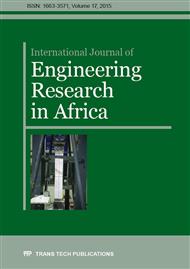p.1
p.8
p.14
p.24
p.30
p.43
p.54
p.64
p.74
Study on Behaviour of Coconut Shell Aggregate Concrete with Bamboo Reinforcement in Compression Member
Abstract:
The use of waste materials is one of the options for sustainable construction. In this paper the coconut shell waste is considered as coarse aggregate (after the same has been crushed) for preparing light weight concrete. The natural material like bamboo which is having considerable tensile strength is considered for reinforcement along with coconut shell concrete. Since the bamboo may absorb moisture from the concrete, to find its effect, the bamboo is treated with water repellent substance like epoxy adhesive is considered. Four types of short columns are tested. Type A Conventional concrete with steel reinforcement, Type B Coconut Shell concrete with steel reinforcement, Type C Coconut Shell concrete with treated bamboo reinforcement, Type D Coconut Shell concrete with untreated bamboo reinforcement. The conclusions drawn from the study are the load carrying capacity of Type B column is 89% of Type A column. For Type D column the ultimate load is 90% of Type C column. For Type C column the ultimate load is 70% of Type A column. For Type D column the ultimate load is 63 % of Type A column. For Type A column the stiffness is higher than the stiffness of Type B, Type C and Type D column. The energy absorption capacity of Type A, Type B columns are higher than that Type C and Type D columns. The epoxy treatment of bamboo has improved the ultimate load capacity by 1.1 times of the Type D column.
Info:
Periodical:
Pages:
14-23
Citation:
Online since:
July 2015
Authors:
Price:
Сopyright:
© 2015 Trans Tech Publications Ltd. All Rights Reserved
Share:
Citation:


